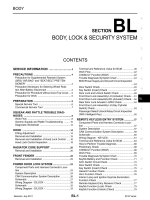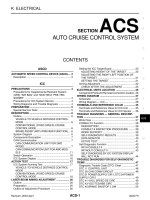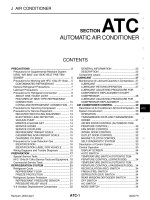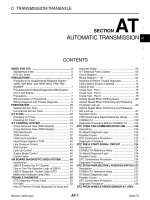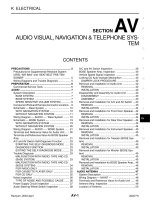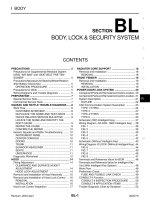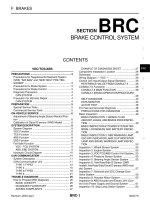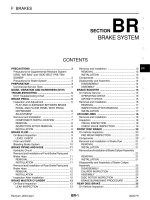HỆ THỐNG KHÓA CỬA, CHỐNG TRỘM TRÊN INFINITI FX35, FX45 2003
Bạn đang xem bản rút gọn của tài liệu. Xem và tải ngay bản đầy đủ của tài liệu tại đây (17.53 MB, 334 trang )
BL-1
BODY, LOCK & SECURITY SYSTEM
I BODY
CONTENTS
C
D
E
F
G
H
J
K
L
M
SECTION BL
A
B
BL
Revision; 2004 April 2003 FX
BODY, LOCK & SECURITY SYSTEM
PRECAUTIONS 5
Precautions for Supplemental Restraint System
(SRS) “AIR BAG” and “SEAT BELT PRE-TEN-
SIONER” 5
Precautions Necessary for Steering Wheel Rotation
After Battery Disconnect 5
OPERATION PROCEDURE 5
Precautions for Work 5
Wiring Diagrams and Trouble Diagnosis 6
PREPARATION 7
Special Service Tools 7
Commercial Service Tools 7
SQUEAK AND RATTLE TROUBLE DIAGNOSIS 8
Work Flow 8
CUSTOMER INTERVIEW 8
DUPLICATE THE NOISE AND TEST DRIVE 9
CHECK RELATED SERVICE BULLETINS 9
LOCATE THE NOISE AND IDENTIFY THE
ROOT CAUSE 9
REPAIR THE CAUSE 9
CONFIRM THE REPAIR 10
Generic Squeak and Rattle Troubleshooting 10
INSTRUMENT PANEL 10
CENTER CONSOLE 10
DOORS 10
TRUNK 11
SUNROOF/HEADLINER 11
SEATS 11
UNDERHOOD 11
Diagnostic Worksheet 12
HOOD 14
Fitting Adjustment 14
CLEARANCE AND SURFACE HEIGHT
ADJUSTMENT 14
HOOD LOCK ADJUSTMENT 14
Removal and Installation of Hood Assembly 15
Removal and Installation of Hood Lock Control 16
REMOVAL 16
INSTALLATION 16
Hood Lock Control Inspection 17
RADIATOR CORE SUPPORT 18
Removal and Installation 18
REMOVAL 18
FRONT FENDER 19
Removal and Installation 19
REMOVAL 19
INSTALLATION 19
POWER DOOR LOCK SYSTEM 20
Component Parts and Harness Connector Location 20
Component Parts and Harness Connector Location 21
System Description 21
OUTLINE 22
CAN Communication System Description 23
TYPE 1/TYPE2 24
TYPE 3 27
TYPE 4/TYPE5 30
TYPE 6 33
Schematic (With Intelligent Key) 37
Wiring Diagram -D/LOCK- (With Intelligent Key) 38
FIG. 1 38
FIG. 2 39
FIG. 3 40
FIG. 4 41
FIG. 5 42
Schematic (Without Intelligent Key) 43
Wiring Diagram -D/LOCK- (Without Intelligent Key) 44
FIG. 6 44
FIG. 7 45
FIG. 8 46
FIG. 9 47
Terminals and Reference Value for BCM 48
Terminals and Reference Value for Intelligent Key
Unit (With Intelligent Key System) 48
Work Flow 48
Preliminary Check 49
FUSE AND FUSIBLE LINK CHECK 49
CONSULT-II Function 50
CONSULT-II INSPECTION PROCEDURE 50
CONSULT-II APPLICATION ITEMS 51
Trouble Diagnosis Chart by Symptom 52
BL-2
Revision; 2004 April 2003 FX
Check Door Switch 53
CHECK DOOR SWITCH (EXCEPT BACK DOOR
SWITCH) 53
CHECK BACK DOOR SWITCH 55
Check Key Switch 57
Check Door Lock and Unlock Switch 59
Check Door Lock Actuator (Driver side) 61
Check Door Lock Actuator (Passenger Side and
Rear LH/RH) 62
Check Fuel Lid Opener Actuator 63
Check Front Door Key Cylinder Switch (Lock) 64
Check Front Door Key Cylinder Switch (Unlock) 65
Check Select Unlock Relay Circuit 66
REMOTE KEYLESS ENTRY SYSTEM 67
Component Parts and Harness Connector Location 67
System Description 68
INPUTS 68
OPERATED PROCEDURE 69
CAN Communication System Description 70
TYPE 1/TYPE2 71
TYPE 3 74
TYPE 4/TYPE5 78
TYPE 6 81
Schematic 85
Wiring Diagram — KEYLES— 86
FIG. 1 86
FIG. 2 87
FIG. 3 88
Terminals and Reference Value for BCM 89
Terminals and Reference Value for IPDM E/R 90
CONSULT-II Function 90
CONSULT-II INSPECTION PROCEDURE 90
CONSULT-II APPLICATION ITEMS 91
Work Flow 93
Trouble Diagnosis Chart by Symptom 94
Check Key Fob Battery and Function 96
Check ACC Switch 97
Check Door Switch 98
CHECK DOOR SWITCH (EXCEPT BACK DOOR
SWITCH) 98
CHECK BACK DOOR SWITCH 100
Check Key Switch 102
Check IPDM E/R Operation 104
Check Hazard Function 105
Check Horn Function 105
Check Headlamp Function 105
Check Map Lamp and Ignition Keyhole Illumination
Function 105
ID Code Entry Procedure 106
KEY FOB ID SET UP WITH CONSULT-II 106
KEY FOB ID SET UP WITHOUT CONSULT-II 108
Key Fob Battery Replacement 109
INTELLIGENT KEY SYSTEM 110
Component Parts and Harness Connector Location .110
System Description 112
DOOR LOCK FUNCTION 112
REMOTE CONTROL ENTRY FUNCTIONS 113
ENGINE STARTUP FUNCTION 114
WARNING AND ALARM FUNCTION 115
CHANGE SETTINGS FUNCTION 118
INTELLIGENT KEY REGISTRATION 118
STEERING LOCK UNIT REGISTRATION 118
CAN Communication System Description 119
TYPE 1/TYPE2 120
TYPE 3 123
TYPE 4/TYPE5 126
TYPE 6 129
Schematic 133
Wiring Diagram — I/KEY— 135
Terminals and Reference Value for INTELLIGENT
KEY UNIT 148
Terminals and Reference Value for Steering Lock
unit 150
Terminals and Reference Value for BCM 150
Terminals and Reference Value for IPDM E/R 151
Diagnosis Procedure 152
WORK FLOW 152
CONSULT-II Functions 153
CONSULT-II Inspection Procedure 153
BASIC OPERATION 153
CONSULT-II Application Items 154
SELF-DIAGNOSTIC RESULTS 154
DATA MONITOR 154
ACTIVE TEST 155
WORK SUPPORT 155
List of Operation Related Parts 156
Trouble Diagnosis Symptom Chart 157
ALL FUNCTIONS OF THE INTELLIGENT KEY
ARE NOT OPERATING 157
REMOTE CONTROL ENTRY FUNCTION MAL-
FUNCTION 157
DOOR LOCK FUNCTION MALFUNCTION 158
ENGINE START FUNCTION MALFUNCTION 159
WARNING CHIME FUNCTION MALFUNCTION .159
Check CAN Communication System Inspection 161
Check Intelligent Key Unit Power Supply and
Ground Circuit 162
Check Key Switch (Intelligent Key Unit Input) 162
Check Key Switch (BCM Input) 164
Check Ignition Knob Switch 165
Check Door Switch 166
CHECK DOOR SWITCH (EXCEPT BACK DOOR
SWITCH) 166
CHECK BACK DOOR SWITCH 168
Check Unlock Sensor 169
Check Door Request Switch 171
Check Intelligent Key Warning Buzzer 172
Check Outside Key Antenna 173
Check Inside Key Antenna 175
Check Steering Lock Unit 176
Check Stop Lamp Switch 178
Check Detention Switch 179
Check Select Unlock Relay 181
Check Hazard Function 182
Check Horn Function 182
Check Headlamp Function 182
Check IPDM E/R Operation 182
Removal and Installation of Intelligent Key Unit 183
BL-3
C
D
E
F
G
H
J
K
L
M
A
B
BL
Revision; 2004 April 2003 FX
REMOVAL 183
INSTALLATION 183
Intelligent Key Inspection 184
INTELLIGENT KEY DISASSEMBLY AND
ASSEMBLY 184
REMOTE CONTROLLER BATTERY INSPEC-
TION 184
DOOR 185
Fitting Adjustment 185
FRONT DOOR 185
REAR DOOR 185
STRIKER ADJUSTMENT 186
Removal and Installation of Front Door 186
REMOVAL 186
INSTALLATION 187
Removal and Installation of Rear Door 187
REMOVAL 187
INSTALLATION 188
Removal and Installation of Door Weathers Trip 188
REMOVAL 188
INSTALLATION 188
FRONT DOOR LOCK 189
Component Structure 189
Removal and Installation 189
REMOVAL 189
INSTALLATION 191
Disassembly and Assembly 192
DOOR KEY CYLINDER ASSEMBLY 192
REAR DOOR LOCK 193
Component Structure 193
Removal and Installation 193
REMOVAL 193
INSTALLATION 195
BACK DOOR 196
Fitting Adjustment 196
VERTICAL/LATERAL CLEARANCE ADJUST-
MENT 196
Back Door Assembly 196
REMOVAL 196
INSTALLATION 197
INSPECTION 197
Removal and Installation of Back Door Striker 197
REMOVAL 197
INSTALLATION 197
Removal and Installation of Back Door Stay 198
REMOVAL 198
INSTALLATION 198
Removal and Installation of Dam Tail Male & Female . 198
REMOVE 198
Removal and Installation of Back Door Weatherstrip . 199
BACK DOOR LOCK ASSEMBLY 200
Removal and Installation of Back Door Lock & Clo-
sure Assembly 200
REMOVAL 200
INSTALLATION 200
INSPECTION 200
Removal and Installation of Back Door Opener
Switch 200
REMOVAL 200
INSTALLATION 200
Disassembly and Assembly 201
BACK DOOR LOCK & CLOSURE ASSEMBLY .201
BACK DOOR AUTO CLOSURE SYSTEM 202
Component Parts and Harness Connector Location .202
System Description 202
CLOSE OPERATION 202
NON-OPERATION CONDITION 202
OPEN OPERATION 203
Wiring Diagram — B/CLOS — 204
Terminals and Reference Value for Back Door Clo-
sure Control Unit 206
Work Flow 207
Preliminary Check 207
Trouble Diagnosis Chart by Symptom 207
Back Door Closure Control Unit Power Supply and
Ground Circuit Check 208
Half-Latch Switch Check 208
Close Switch Check 210
Open Switch Check 211
Back Door Opener Switch Check 212
Unlock Sensor Check 213
Closure Motor Check 214
Removal and Installation of Back Door Closer Con-
trol Unit 215
VEHICLE SECURITY (THEFT WARNING) SYSTEM .216
Component Parts and Harness Connector Location .216
System Description 217
DESCRIPTION 217
POWER SUPPLY 218
INITIAL CONDITION TO ACTIVATE THE SYS-
TEM 218
VEHICLE SECURITY SYSTEM ALARM OPER-
ATION 219
VEHICLE SECURITY SYSTEM DEACTIVATION .219
PANIC ALARM OPERATION 219
CAN Communication System Description 220
CAN Communication Unit 220
TYPE 1/TYPE2 221
TYPE 3 224
TYPE 4/TYPE5 227
TYPE 6 230
Schematic 234
Wiring Diagram -VEHSEC- 235
Terminals and Reference Value for BCM 240
Terminals and Reference Value for IPDM E/R 240
CONSULT-II Inspection Procedure 241
CONSULT-II APPLICATION ITEM 242
Trouble Diagnosis 243
WORK FLOW 243
Preliminary Check 244
Trouble Diagnosis Symptom Chart 245
Diagnostic Procedure 1 246
1 – 1 DOOR SWITCH CHECK 246
1 – 2 HOOD SWITCH CHECK 248
1 – 3 BACK DOOR SWITCH CHECK 249
Diagnostic Procedure 2 251
SECURITY INDICATOR LAMP CHECK 251
Diagnostic Procedure 3 252
BL-4
Revision; 2004 April 2003 FX
FRONT DOOR KEY CYLINDER SWITCH
CHECK 252
Diagnostic Procedure 4 252
VEHICLE SECURITY HORN ALARM CHECK .252
Diagnostic Procedure 5 252
VEHICLE SECURITY HEADLAMP ALARM
CHECK 252
Diagnostic Procedure 6 252
DOOR LOCK AND UNLOCK SWITCH CHECK .252
IVIS (INFINITI VEHICLE IMMOBILIZER SYSTEM-
NATS) 253
Component Parts and Harness Connector Location .253
System Description 253
DESCRIPTION 253
SECURITY INDICATOR 255
System Composition 255
ECM Re-communicating Function 256
Wiring Diagram – NATS – 257
MODELS WITH INTELLIGENT KEY SYSTEM .257
MODELS WITHOUT INTELLIGENT KEY SYS-
TEM 259
Terminals and Reference Value for Steering Lock
Unit/with Intelligent Key System 260
Terminals and Reference Value for Intelligent Key
Unit/with Intelligent Key System 260
Terminals and Reference Value for BCM 261
CONSULT-II 262
CONSULT-II INSPECTION PROCEDURE 262
CONSULT-II DIAGNOSTIC TEST MODE FUNC-
TION 262
HOW TO READ SELF-DIAGNOSTIC RESULTS .263
NATS SELF-DIAGNOSTIC RESULT ITEM
CHART 263
Diagnosis Procedure 264
WORK FLOW 264
Trouble Diagnosis Symptom Chart 265
Security Indicator Inspection 265
Diagnostic Procedure 1 266
Diagnostic Procedure 2 267
Diagnostic Procedure 3 268
Diagnostic Procedure 4 269
Diagnostic Procedure 5 270
Diagnostic Procedure 6 271
Diagnostic Procedure 7 273
Removal and Installation NATS Antenna Amp. 274
REMOVAL 274
INSTALLATION 274
INTEGRATED HOMELINK TRANSMITTER 275
Wiring Diagram —TRNSCV— 275
Trouble Diagnoses 276
DIAGNOSTIC PROCEDURE 276
BODY REPAIR 278
Body Exterior Paint Color 278
Body Component Parts 279
UNDERBODY COMPONENT PARTS 279
BODY COMPONENT PARTS 281
Corrosion Protection 283
DESCRIPTION 283
ANTI-CORROSIVE WAX 284
UNDERCOATING 285
STONE GUARD COAT 286
Body Sealing 287
DESCRIPTION 287
Body Construction 290
BODY CONSTRUCTION 290
Body Alignment 291
BODY CENTER MARKS 291
PANEL PARTS MATCHING MARKS 292
DESCRIPTION 293
ENGINE COMPARTMENT 294
UNDERBODY 296
PASSENGER COMPARTMENT 298
REAR BODY 300
Handling Precautions For Plastics 302
HANDLING PRECAUTIONS FOR PLASTICS 302
LOCATION OF PLASTIC PARTS 303
Precautions In Repairing High Strength Steel 305
HIGH STRENGTH STEEL (HSS) USED IN NIS-
SAN VEHICLES 305
Replacement Operations 308
DESCRIPTION 308
HOODLEDGE 311
FRONT SIDE MEMBER 313
FRONT SIDE MEMBER (PARTIAL REPLACE-
MENT) 315
FRONT PILLAR 317
CENTER PILLAR 319
OUTER SILL 321
REAR FENDER 323
REAR PANEL 325
REAR END CROSSMEMBER 327
REAR FLOOR REAR 329
REAR SIDE MEMBER EXTENSION 332
PRECAUTIONS
BL-5
C
D
E
F
G
H
J
K
L
M
A
B
BL
Revision; 2004 April 2003 FX
PRECAUTIONS PFP:00001
Precautions for Supplemental Restraint System (SRS) “AIR BAG” and “SEAT
BELT PRE-TENSIONER”
AIS00392
The Supplemental Restraint System such as “AIR BAG” and “SEAT BELT PRE-TENSIONER”, used along
with a front seat belt, helps to reduce the risk or severity of injury to the driver and front passenger for certain
types of collision. This system includes seat belt switch inputs and dual stage front air bag modules. The SRS
system uses the seat belt switches to determine the front air bag deployment, and may only deploy one front
air bag, depending on the severity of a collision and whether the front occupants are belted or unbelted.
Information necessary to service the system safely is included in the SRS and SB section of this Service Man-
ual.
WARNING:
● To avoid rendering the SRS inoperative, which could increase the risk of personal injury or death
in the event of a collision which would result in air bag inflation, all maintenance must be per-
formed by an authorized NISSAN/INFINITI dealer.
● Improper maintenance, including incorrect removal and installation of the SRS, can lead to per-
sonal injury caused by unintentional activation of the system. For removal of Spiral Cable and Air
Bag Module, see the SRS section.
● Do not use electrical test equipment on any circuit related to the SRS unless instructed to in this
Service Manual. SRS wiring harnesses can be identified by yellow and/or orange harnesses or
harness connectors.
Precautions Necessary for Steering Wheel Rotation After Battery Disconnect
AIS005WS
NOTE:
● This Procedure is applied only to models with Intelligent Key system and NVIS/IVIS (NISSAN/INFINITI
VEHICLE IMMOBILIZER SYSTEM - NATS).
● Remove and install all control units after disconnecting both battery cables with the ignition knob in the
″LOCK″ position.
● Always use CONSULT-II to perform self-diagnosis as a part of each function inspection after finishing
work. If DTC is detected, perform trouble diagnosis according to self-diagnostic results.
For models equipped with the Intelligent Key system and NVIS/IVIS, an electrically controlled steering lock
mechanism is adopted on the key cylinder.
For this reason, if the battery is disconnected or if the battery is discharged, the steering wheel will lock and
steering wheel rotation will become impossible.
If steering wheel rotation is required when battery power is interrupted, follow the procedure below before
starting the repair operation.
OPERATION PROCEDURE
1. Connect both battery cables.
NOTE:
Supply power using jumper cables if battery is discharged.
2. Use the Intelligent Key or mechanical key to turn the ignition switch to the ″ACC″ position. At this time, the
steering lock will be released.
3. Disconnect both battery cables. The steering lock will remain released and the steering wheel can be
rotated.
4. Perform the necessary repair operation.
5. When the repair work is completed, return the ignition switch to the ″LOCK″ position before connecting
the battery cables. (At this time, the steering lock mechanism will engage.)
6. Perform a self-diagnosis check of all control units using CONSULT-II.
Precautions for Work AIS00393
● After removing and installing the opening/closing parts, be sure to carry out fitting adjustments to check
their operation.
● Check the lubrication level, damage, and wear of each part. If necessary, grease or replace it.
BL-6
PRECAUTIONS
Revision; 2004 April 2003 FX
Wiring Diagrams and Trouble Diagnosis AIS00394
When you read wiring diagrams, refer to the following:
● GI-15, "How to Read Wiring Diagrams"
● PG-3, "POWER SUPPLY ROUTING CIRCUIT"
When you perform trouble diagnosis, refer to the following:
● GI-11, "HOW TO FOLLOW TEST GROUPS IN TROUBLE DIAGNOSES"
● GI-27, "How to Perform Efficient Diagnosis for an Electrical Incident"
Check for any Service bulletins before servicing the vehicle.
PREPARATION
BL-7
C
D
E
F
G
H
J
K
L
M
A
B
BL
Revision; 2004 April 2003 FX
PREPARATION PFP:00002
Special Service Tools AIS00395
The actual shapes of Kent-Moore tools may differ from those of special service tools illustrated here.
Commercial Service Tools AIS00396
Tool number
(Kent-Moore No.)
Tool name
Description
(J-39570)
Chassis ear
Locating the noise
(J-43980)
NISSAN Squeak and
Rattle Kit
Repairing the cause of the noise
SIIA0993E
SIIA0994E
Tool name Description
Engine ear Locating the noise
Power tool Loosening bolts and nuts
SIIA0995E
PIIB1407E
BL-8
SQUEAK AND RATTLE TROUBLE DIAGNOSIS
Revision; 2004 April 2003 FX
SQUEAK AND RATTLE TROUBLE DIAGNOSIS PFP:00000
Work Flow AIS00397
CUSTOMER INTERVIEW
Interview the customer if possible, to determine the conditions that exist when the noise occurs. Use the Diag-
nostic Worksheet during the interview to document the facts and conditions when the noise occurs and any
customer's comments; refer to BL-12, "
Diagnostic Worksheet" . This information is necessary to duplicate the
conditions that exist when the noise occurs.
● The customer may not be able to provide a detailed description or the location of the noise. Attempt to
obtain all the facts and conditions that exist when the noise occurs (or does not occur).
● If there is more than one noise in the vehicle, be sure to diagnose and repair the noise that the customer
is concerned about. This can be accomplished by test driving the vehicle with the customer.
● After identifying the type of noise, isolate the noise in terms of its characteristics. The noise characteristics
are provided so the customer, service adviser and technician are all speaking the same language when
defining the noise.
● Squeak —(Like tennis shoes on a clean floor)
Squeak characteristics include the light contact/fast movement/brought on by road conditions/hard sur-
faces=higher pitch noise/softer surfaces=lower pitch noises/edge to surface=chirping
● Creak—(Like walking on an old wooden floor)
Creak characteristics include firm contact/slow movement/twisting with a rotational movement/pitch
dependent on materials/often brought on by activity.
● Rattle—(Like shaking a baby rattle)
Rattle characteristics include the fast repeated contact/vibration or similar movement/loose parts/missing
clip or fastener/incorrect clearance.
● Knock —(Like a knock on a door)
Knock characteristics include hollow sounding/sometimes repeating/often brought on by driver action.
● Tick—(Like a clock second hand)
Tick characteristics include gentle contacting of light materials/loose components/can be caused by driver
action or road conditions.
● Thump—(Heavy, muffled knock noise)
Thump characteristics include softer knock/dead sound often brought on by activity.
● Buzz—(Like a bumble bee)
Buzz characteristics include high frequency rattle/firm contact.
● Often the degree of acceptable noise level will vary depending upon the person. A noise that you may
judge as acceptable may be very irritating to the customer.
● Weather conditions, especially humidity and temperature, may have a great effect on noise level.
SBT842
SQUEAK AND RATTLE TROUBLE DIAGNOSIS
BL-9
C
D
E
F
G
H
J
K
L
M
A
B
BL
Revision; 2004 April 2003 FX
DUPLICATE THE NOISE AND TEST DRIVE
If possible, drive the vehicle with the customer until the noise is duplicated. Note any additional information on
the Diagnostic Worksheet regarding the conditions or location of the noise. This information can be used to
duplicate the same conditions when you confirm the repair.
If the noise can be duplicated easily during the test drive, to help identify the source of the noise, try to dupli-
cate the noise with the vehicle stopped by doing one or all of the following:
1) Close a door.
2) Tap or push/pull around the area where the noise appears to be coming from.
3) Rev the engine.
4) Use a floor jack to recreate vehicle "twist".
5) At idle, apply engine load (electrical load, half-clutch on M/T model, drive position on A/T model).
6) Raise the vehicle on a hoist and hit a tire with a rubber hammer.
● Drive the vehicle and attempt to duplicate the conditions the customer states exist when the noise occurs.
● If it is difficult to duplicate the noise, drive the vehicle slowly on an undulating or rough road to stress the
vehicle body.
CHECK RELATED SERVICE BULLETINS
After verifying the customer concern or symptom, check ASIST for Technical Service Bulletins (TSBs) related
to that concern or symptom.
If a TSB relates to the symptom, follow the procedure to repair the noise.
LOCATE THE NOISE AND IDENTIFY THE ROOT CAUSE
1. Narrow down the noise to a general area. To help pinpoint the source of the noise, use a listening tool
(Chassis Ear: J-39570, Engine Ear and mechanics stethoscope).
2. Narrow down the noise to a more specific area and identify the cause of the noise by:
● removing the components in the area that you suspect the noise is coming from.
Do not use too much force when removing clips and fasteners, otherwise clips and fastener can be broken
or lost during the repair, resulting in the creation of new noise.
● tapping or pushing/pulling the component that you suspect is causing the noise.
Do not tap or push/pull the component with excessive force, otherwise the noise will only be eliminated
temporarily.
● feeling for a vibration with your hand by touching the component(s) that you suspect is (are) causing the
noise.
● placing a piece of paper between components that you suspect are causing the noise.
● looking for loose components and contact marks.
Refer to BL-10, "
Generic Squeak and Rattle Troubleshooting" .
REPAIR THE CAUSE
● If the cause is a loose component, tighten the component securely.
● If the cause is insufficient clearance between components:
– separate components by repositioning or loosening and retightening the component, if possible.
– insulate components with a suitable insulator such as urethane pads, foam blocks, felt cloth tape or ure-
thane tape. A Nissan Squeak and Rattle Kit (J-43980) is available through your authorized Nissan Parts
Department.
CAUTION:
Do not use excessive force as many components are constructed of plastic and may be damaged.
Always check with the Parts Department for the latest parts information.
The following materials are contained in the Nissan Squeak and Rattle Kit (J-43980). Each item can be
ordered separately as needed.
URETHANE PADS [1.5 mm (0.059 in) thick]
Insulates connectors, harness, etc.
76268-9E005: 100 × 135 mm (3.94 × 5.31 in)/76884-71L01: 60 × 85 mm (2.36 × 3.35 in)/76884-71L02: 15
× 25 mm(0.59 × 0.98 in)
INSULATOR (Foam blocks)
Insulates components from contact. Can be used to fill space behind a panel.
73982-9E000: 45 mm (1.77 in) thick, 50 × 50 mm (1.97 × 1.97 in)/73982-50Y00: 10 mm (0.39 in) thick,
50 × 50 mm (1.97 × 1.97 in)
BL-10
SQUEAK AND RATTLE TROUBLE DIAGNOSIS
Revision; 2004 April 2003 FX
INSULATOR (Light foam block)
80845-71L00: 30 mm (1.18 in) thick, 30 × 50 mm (1.18×1.97 in)
FELT CLOTHTAPE
Used to insulate where movement does not occur. Ideal for instrument panel applications.
68370-4B000: 15 × 25 mm (0.59 × 0.98 in) pad/68239-13E00: 5 mm (0.20 in) wide tape roll The following
materials, not found in the kit, can also be used to repair squeaks and rattles.
UHMW(TEFLON) TAPE
Insulates where slight movement is present. Ideal for instrument panel applications.
SILICONE GREASE
Used in place of UHMW tape that will be visible or not fit.
Note: Will only last a few months.
SILICONE SPRAY
Use when grease cannot be applied.
DUCT TAPE
Use to eliminate movement.
CONFIRM THE REPAIR
Confirm that the cause of a noise is repaired by test driving the vehicle. Operate the vehicle under the same
conditions as when the noise originally occurred. Refer to the notes on the Diagnostic Worksheet.
Generic Squeak and Rattle Troubleshooting AIS00398
Refer to Table of Contents for specific component removal and installation information.
INSTRUMENT PANEL
Most incidents are caused by contact and movement between:
1. The cluster lid A and instrument panel
2. Acrylic lens and combination meter housing
3. Instrument panel to front pillar garnish
4. Instrument panel to windshield
5. Instrument panel mounting pins
6. Wiring harnesses behind the combination meter
7. A/C defroster duct and duct joint
These incidents can usually be located by tapping or moving the components to duplicate the noise or by
pressing on the components while driving to stop the noise. Most of these incidents can be repaired by apply-
ing felt cloth tape or silicon spray (in hard to reach areas). Urethane pads can be used to insulate wiring har-
ness.
CAUTION:
Do not use silicone spray to isolate a squeak or rattle. If you saturate the area with silicone, you will
not be able to recheck the repair.
CENTER CONSOLE
Components to pay attention to include:
1. Shifter assembly cover to finisher
2. A/C control unit and cluster lid C
3. Wiring harnesses behind audio and A/C control unit
The instrument panel repair and isolation procedures also apply to the center console.
DOORS
Pay attention to the:
1. Finisher and inner panel making a slapping noise
2. Inside handle escutcheon to door finisher
3. Wiring harnesses tapping
4. Door striker out of alignment causing a popping noise on starts and stops
Tapping or moving the components or pressing on them while driving to duplicate the conditions can isolate
many of these incidents. You can usually insulate the areas with felt cloth tape or insulator foam blocks from
the Nissan Squeak and Rattle Kit (J-43980) to repair the noise.
SQUEAK AND RATTLE TROUBLE DIAGNOSIS
BL-11
C
D
E
F
G
H
J
K
L
M
A
B
BL
Revision; 2004 April 2003 FX
TRUNK
Trunk noises are often caused by a loose jack or loose items put into the trunk by the owner.
In addition look for:
1. Trunk lid dumpers out of adjustment
2. Trunk lid striker out of adjustment
3. The trunk lid torsion bars knocking together
4. A loose license plate or bracket
Most of these incidents can be repaired by adjusting, securing or insulating the item(s) or component(s) caus-
ing the noise.
SUNROOF/HEADLINER
Noises in the sunroof/headliner area can often be traced to one of the following:
1. Sunroof lid, rail, linkage or seals making a rattle or light knocking noise
2. Sunvisor shaft shaking in the holder
3. Front or rear windshield touching headliner and squeaking
Again, pressing on the components to stop the noise while duplicating the conditions can isolate most of these
incidents. Repairs usually consist of insulating with felt cloth tape.
SEATS
When isolating seat noise it's important to note the position the seat is in and the load placed on the seat when
the noise is present. These conditions should be duplicated when verifying and isolating the cause of the
noise.
Cause of seat noise include:
1. Headrest rods and holder
2. A squeak between the seat pad cushion and frame
3. The rear seatback lock and bracket
These noises can be isolated by moving or pressing on the suspected components while duplicating the con-
ditions under which the noise occurs. Most of these incidents can be repaired by repositioning the component
or applying urethane tape to the contact area.
UNDERHOOD
Some interior noise may be caused by components under the hood or on the engine wall. The noise is then
transmitted into the passenger room.
Causes of transmitted underhood noise include:
1. Any component mounted to the engine wall
2. Components that pass through the engine wall
3. Engine wall mounts and connectors
4. Loose radiator mounting pins
5. Hood bumpers out of adjustment
6. Hood striker out of adjustment
These noises can be difficult to isolate since they cannot be reached from the interior of the vehicle. The best
method is to secure, move or insulate one component at a time and test drive the vehicle. Also, engine RPM
or load can be changed to isolate the noise. Repairs can usually be made by moving, adjusting securing, or
insulating the component causing the noise.
BL-12
SQUEAK AND RATTLE TROUBLE DIAGNOSIS
Revision; 2004 April 2003 FX
Diagnostic Worksheet AIS00399
SBT860
SQUEAK AND RATTLE TROUBLE DIAGNOSIS
BL-13
C
D
E
F
G
H
J
K
L
M
A
B
BL
Revision; 2004 April 2003 FX
SBT844
BL-14
HOOD
Revision; 2004 April 2003 FX
HOOD PFP:F5100
Fitting Adjustment AIS0039A
CLEARANCE AND SURFACE HEIGHT ADJUSTMENT
1. Remove the hood lock assembly and adjust the height by rotating the bumper rubber until the hood clear-
ance of hood and fender becomes 1 mm (0.04 in) lower than fitting standard dimension.
2. Temporarily tighten the hood lock, and position it by engaging it with the hood striker. Check the lock and
striker for looseness, and tighten the lock mounting bolt to the specified torque.
3. Adjust the clearance and surface height of hood and fender according to the fitting standard dimension by
rotating right and left bumper rubbers.
CAUTION:
Adjust right/left gap between hood and each part to the following specification.
HOOD LOCK ADJUSTMENT
1. Move the hood lock to the left or right so that striker center is vertically aligned with hood lock center
(when viewed from vehicle front).
2. Make sure the secondary latch is properly engaged with the sec-
ondary striker with hood's own weight by dropping it from
approx. 200 mm (7.87 in) height or by pressing it lightly approx.
3 kg (29 N, 7lb).
CAUTION:
Do not drop the hood from 300 mm (11.81 in) height or
higher.
3. After adjusting hood lock, tighten the lock mounting bolts to the
specified torque.
1. Hood hinge 2. Nut 3. Hood stay
4. Hood lock 5. Bolt
PIIA6057E
Hood and front fender (D–D) : Less than 2.0 mm (0.08 in)
PIIA3806E
HOOD
BL-15
C
D
E
F
G
H
J
K
L
M
A
B
BL
Revision; 2004 April 2003 FX
Removal and Installation of Hood Assembly AIS0039B
1. Support the hood striker with a proper material to prevent it from
falling.
WARNING:
Body injury may occur if no supporting rod is holding the
hood open when removing the damper stay.
2. Remove the hood stays from the stud balls on the body side.
3. Remove the hinge mounting nuts on the hood to remove the hood assembly.
CAUTION:
Operate with two workers, because of its heavy weight.
Install in the reverse order of removal.
1. Hood assembly 2. Hood front sealing rubber 3. Hood insulator
4. Hood hinge 5. Hood stay 6. Hood lock
7. Bolts 8. Nuts
PIIA6016E
PIIA6058E
BL-16
HOOD
Revision; 2004 April 2003 FX
Removal and Installation of Hood Lock Control AIS0039C
REMOVAL
1. Remove the front grill. Refer to EI-23, "Removal and Installation" .
2. Remove the front fender protector (LH). Refer to EI-25, "Removal and Installation" .
3. Disconnect the hood lock cable from the hood lock, and clip it from the radiator core support upper and
hood ledge.
4. Remove instrument driver lower panel. Refer to IP-11, "
Removal and Installation" .
5. After the bolt of the case with the air cleaner is disconnected, and it is moved, the cable is pulled.
6. Remove the grommet on the dashboard, and pull the hood lock cable toward the passenger room.
CAUTION:
While pulling, be careful not to damage (peeling) the outside of the hood lock cable.
INSTALLATION
1. Pull the hood lock cable through the panel hole to the engine room.
Be careful not to bend the cable too much, keeping the radius
100mm (3.94 in) or more.
2. Mack sure the cable is not offset from the positioning grommet,
and push the grommet into the panel hole securely.
3. Apply the sealant to the grommet (at * mark) properly.
1. Hood lock 2. Hood lock cable 3. Clip
4. Hood ledge upper front LH 5. Dash lower cross member reinforce LH
PIIA6017E
PIIA0173E
HOOD
BL-17
C
D
E
F
G
H
J
K
L
M
A
B
BL
Revision; 2004 April 2003 FX
4. Install the cable securely to the lock.
5. After installing, check the hood lock adjustment and hood
opener operation.
Hood Lock Control Inspection AIS0039D
CAUTION:
If the hood lock cable is bent or deformed, replace it.
1. Mack sure the secondary latch is properly engaged with the sec-
ondary striker with hood's own weight by dropping it from
approx. 200 mm (7.87 in) height.
2. While operating the hood opener, carefully mack sure the front
end of the hood is raised by approx. 20 mm (0.79 in). Also mack
sure the hood opener returns to the original position.
3. Check the hood lock lubrication condition. If necessary, apply
“body grease” to the points shown in the figure.
PIIA3552E
PIIA1086E
PIIA3550E
BL-18
RADIATOR CORE SUPPORT
Revision; 2004 April 2003 FX
RADIATOR CORE SUPPORT PFP:62500
Removal and Installation AIS0039E
REMOVAL
1. Remove the front fender protector. Refer to EI-25, "Removal and Installation" .
2. Remove the front bumper. Refer to EI-14, "
Removal and Installation" .
3. Remove the ICC. Refer to ACS-74, "
REMOVAL AND INSTALLATION" .
4. Remove the headlamp. Refer to LT-49, "
Removal and Installation" .
5. Remove the washer tank. Refer to WW-48, "
Removal and Installation of Washer Tank" .
6. Remove the resonator. Refer to EM-170, "
AIR CLEANER AND AIR DUCT"
7. Remove the power steering oil cooler. Refer to PS-41, "HYDRAULIC LINE" .
8. Remove the ambient sensor. Refer to ATC-129, "
Removal and Installation" .
9. Remove the crash zone sensor. Refer to SRS-46, "
CRASH ZONE SENSOR" .
10. Remove the horn connector, blower fan connector and harness clip.
11. Remove the hood lock and disconnect hood lock control cable. Refer to BL-16, "Removal and Installation
of Hood Lock Control" .
12. Remove the reservoir tank. Refer to EM-170, "
AIR CLEANER AND AIR DUCT"
13. Remove mounting blots and remove the radiator core support. Remove mounting bolts with power tool.
14. After remove radiator core support, remove the horn, cooling fan.
1. Radiator core support assembly 2. Bolt 3. Bolt
4. Horn (High) 5. Air guide (LH) 6. Cooling fan
7. Air guide (LH) 8. Horn (Low)
PIIA6018E
FRONT FENDER
BL-19
C
D
E
F
G
H
J
K
L
M
A
B
BL
Revision; 2004 April 2003 FX
FRONT FENDER PFP:63100
Removal and Installation AIS003C4
REMOVAL
1. Remove the front bumper. Refer to EI-14, "Removal and Installation" .
2. Remove the headlamp. Refer to LT-49, "
Removal and Installation" .
3. Remove the front fender protector. Refer to EI-25, "
Removal and Installation" .
4. Remove the mounting bolt and remove the front fender.
CAUTION:
While removing use a shop cloth to protect body from damaging.
INSTALLATION
Install in the reverse order of removal.
CAUTION:
● After installing, apply touch-up paint (the body color) onto the head of the front fender mounting
bolts.
● After installing, check front fender adjustment. Refer to BL-14, "Fitting Adjustment" and BL-185,
"Fitting Adjustment" .
1. Front fender 2. Bolt (7)
PIIA6076E
BL-20
POWER DOOR LOCK SYSTEM
Revision; 2004 April 2003 FX
POWER DOOR LOCK SYSTEM PFP:24814
Component Parts and Harness Connector Location AIS003L2
PIIA6411E
POWER DOOR LOCK SYSTEM
BL-21
C
D
E
F
G
H
J
K
L
M
A
B
BL
Revision; 2004 April 2003 FX
Component Parts and Harness Connector Location AIS00355
System Description AIS00356
Power is supplied at all times
● to BCM terminal 55
● through 50A fusible link (letter M , located in the fuse and fusible link box).
● to BCM terminal 42
● thought 15A fuse [No. 22, located in the fuse block (J/B)]
● to key switch terminal 2 (without intelligent key system)
● thought 15A fuse [No. 22, located in the fuse block (J/B)]
● to key switch terminal 3 (with intelligent key system)
● thought 15A fuse [No. 22, located in the fuse block (J/B)].
When key switch is ON (key is inserted in ignition key cylinder), power is supplied
● to BCM terminal 37
● through key switch terminal 1 (without intelligent key system) or 4 (with intelligent key system).
When the door is locked or unlocked with power window main switch (door lock and unlock switch), ground is
supplied
● to CPU of power window main switch
● through power window main switch (door lock and unlock switch) terminal 17
● through grounds M35, M45 and M85.
Then power window main switch (door lock and unlock switch) operation signal is supplied.
● to BCM terminal 22
● through power window main switch terminal 14.
When the door is locked or unlocked with front power window switch (passenger side) (door lock and unlock
switch), ground is supplied
● to CPU of front power window switch (passenger side)
● through front power window switch (passenger side) (door lock and unlock switch) terminal 11
● through grounds M35, M45 and M85.
Then front power window switch (passenger side) (door lock and unlock switch) operation signal is supplied
● to BCM terminal 22
● through front power window switch (passenger side) terminal 16.
When the door is locked with front door key cylinder switch, ground is supplied
● to power window main switch terminal 4
● through key cylinder switch terminals 1 and 5
● through grounds M35, M45 and M85.
PIIA6412E
BL-22
POWER DOOR LOCK SYSTEM
Revision; 2004 April 2003 FX
Then key cylinder switch operation signal (lock) is supplied
● to BCM terminal 22
● through power window main switch terminal 14.
When the door is unlocked with key cylinder switch, ground is supplied
● to power window main switch terminal 6
● through key cylinder switch terminal 6 and 5
● through grounds M35, M45 and M85.
Then key cylinder switch operation signal (unlock) is supplied
● to BCM terminal 22
● through power window main switch terminal 14.
BCM is connected to power window main switch and front power window switch (passenger side) as serial
link.
When the front door switch (driver side) is ON (door is OPEN), ground is supplied
● to BCM terminal 62
● through front door switch (driver side) terminal 1
● through front door switch (driver side) case ground.
When the front door switch (passenger side) is ON (door is OPEN), ground is supplied
● to BCM terminal 12
● through front door switch (passenger side) terminal 1
● through front door switch (passenger side) case ground.
When the rear door switch LH is ON (door is OPEN), ground is supplied
● to BCM terminal 63
● through front door switch LH terminal 1
● through rear door switch LH case ground.
When the rear door switch RH is ON (door is OPEN), ground is supplied
● to BCM terminal 13
● through front door switch RH terminal 1
● through rear door switch RH case ground.
When the back door switch are ON (door is OPEN), ground is supplied
● to BCM terminal 58
● through back door closure motor (door switch) terminal 7 and 8
● through grounds M15 and M45.
OUTLINE
Functions Available by Operating the Door Lock and Unlock Switches on Driver's Door and
Passenger's Door
● Interlocked with the locking operation of door lock and unlock switch, door lock actuators of all doors and
fuel lid lock actuator are locked.
● Interlocked with the unlocking operation of door lock and unlock switch, door lock actuators of all doors
and fuel lid lock actuator are unlocked.
Functions Available by Operating the Key Cylinder Switch on Driver's
● Interlocked with the locking operation of door key cylinder, door lock actuators of all doors and fuel lid lock
actuator are locked.
Select Unlock Operation
● When door key cylinder is unlocked, door lock actuator driver side and fuel lid lock actuator are unlocked.
● When door key cylinder is unlocked for the second time within 5 seconds after the first operation, door
lock actuators on all doors are unlocked.
Select unlock operation mode can be changed using “DOOR LOCK-UNLOCK SET” mode in “WORK
SUPPORT”. Refer to BL-51, "
Work Support" .
Select unlock operation mode can be changed also on the display.
Refer toAV-56, "
SETTING SCREEN" . (without navigation system)
POWER DOOR LOCK SYSTEM
BL-23
C
D
E
F
G
H
J
K
L
M
A
B
BL
Revision; 2004 April 2003 FX
Refer to AV-107, "Vehicle Electronic Systems" . (with navigation system)
Key Reminder Door System
When door lock and unlock switch is operated to lock doors with ignition key put in key cylinder and any door
open, all door lock actuators are locked and then unlocked.
Key reminder door mode can be changed using “WORK SUPPORT” mode in “ANTI-LOCK OUT SET”.
Refer to BL-51, "
Work Support" .
CAN Communication System Description AIS003MQ
CAN (Controller Area Network) is a serial communication line for real time application. It is an on-vehicle mul-
tiplex communication line with high data communication speed and excellent error detection ability. Many elec-
tronic control units are equipped onto a vehicle, and each control unit shares information and links with other
control units during operation (not independent). In CAN communication, control units are connected with 2
communication lines (CAN H line, CAN L line) allowing a high rate of information transmission with less wiring.
Each control unit transmits/receives data but selectively reads required data only.
×: Applicable
Body type Wagon
Axle 2WD AWD
Engine VQ35DE VQ35DE/VK45DE
Transmission A/T
Brake control VDC
Navigation system ××
Low tire pressure warning system ××
ICC system ××
Intelligent Key system ××
Automatic drive positioner ×× ××
CAN communication unit
ECM ××××××
TCM ××××××
Display unit ×× ××
Display control unit ××
Low tire pressure warning control unit ××
AWD control unit ×××
ICC unit ××
Intelligent Key unit ××
Data link connector ××××××
BCM ××××××
Steering angle sensor ××××××
Unified meter and A/C amp. ××××××
ICC sensor ××
ABS actuator and electric unit (control unit) ××××××
Driver seat control unit ×× ××
IPDM E/R ××××××
CAN communication type BL-24, "
TYPE 1/TYPE2"
BL-27,
"TYPE 3"
BL-30, "TYPE 4/TYPE5"
BL-33,
"TYPE 6"
BL-24
POWER DOOR LOCK SYSTEM
Revision; 2004 April 2003 FX
TYPE 1/TYPE2
System Diagram
● Type1
● Type2
Input/output Signal Chart
T: Transmit R: Receive
SKIA6171E
SKIA6172E
Signals ECM TCM
Dis-
play
unit
BCM
Steer-
ing
angle
sensor
Unified
meter
and A/
C amp.
ABS
actua-
tor and
electric
unit
(con-
trol
unit)
Driver
seat
control
unit
IPDM
E/R
Engine speed signal T R R R R
Engine status signal T R
Engine coolant temperature signal T R R
A/T self-diagnosis signal R T
Accelerator pedal position signal T R R
Closed throttle position signal T R
Wide open throttle position signal T R
POWER DOOR LOCK SYSTEM
BL-25
C
D
E
F
G
H
J
K
L
M
A
B
BL
Revision; 2004 April 2003 FX
Battery voltage signal T R
Key switch signal T R
Ignition switch signal T R R
P range signal T R R
Stop lamp switch signal R T
ABS operation signal R T
TCS operation signal R T
VDC operation signal R T
Fuel consumption monitor signal T R R
Input shaft revolution signal R T
Output shaft revolution signal R T
A/C switch signal R T
A/C compressor request signal T R
A/C relay status signal R T
A/C compressor feedback signal T R
Blower fan motor switch signal R T
A/C control signal
TR
RT
Cooling fan speed request signal T R
Cooling fan speed signal R T
Position light request signal R T R R
Low beam request signal T R
Low beam status signal R T
High beam request signal T R R
High beam status signal R T
Front fog light request signal T R
Day time running light request signal T R
Turn LED burnout status signal R T
Vehicle speed signal
RT
RRRR T R
Sleep wake up signal T R R R
Door switch signal R T R R R
Turn indicator signal T R
Key fob ID signal T R
Key fob door unlock signal T R
Oil pressure switch signal
RT
TR
Buzzer output signal T R
Fuel level sensor signal R T
Fuel level low warning signal R T
Signals ECM TCM
Dis-
play
unit
BCM
Steer-
ing
angle
sensor
Unified
meter
and A/
C amp.
ABS
actua-
tor and
electric
unit
(con-
trol
unit)
Driver
seat
control
unit
IPDM
E/R
